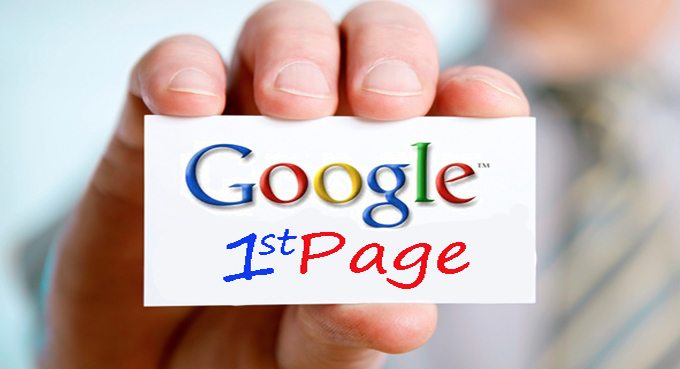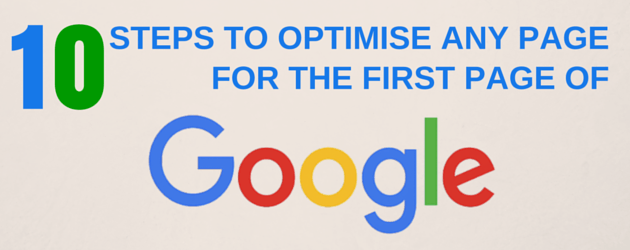How hard is it to come up at the top of Google search results? Every business and website owner dreams of ranking number one on Google. The reasons are clear: reaching that top spot (or even one of the top three spots) would mean increased traffic to your site, visibility and the potential for sales to catapult your business ahead of the competition.
Unfortunately, high rankings rarely happen by chance. Even the most skilled and knowledgeable marketers struggle with getting the top-ranking spot. So, how can a regular business owner hope to achieve this feat? While there’s no way to absolutely guarantee high rankings, this post will look at some strategies anyone can use to seriously increase their chances of claiming that #1 spot.
Each year, Google changes its search algorithm around 500–600 times. While most of these changes are minor, Google occasionally rolls out a “major” algorithmic update (such as Google Panda and Google Penguin) that affects search results in significant ways.

You want your business to remain the number one choice that appears on Google, the moment your potential customer is in need. Let’s be honest, you’ve got tough competition. Why? You might ask. You’re NOT the only business asking the magical Google Gods to grant your most desired wishes. We all have a specific “want” or intention when we’re in search of an answer to a problem. However, as individuals, we fail to understand what we “need” to do to reach our most desired request. It’s time to break down your needs. Let’s learn how to stay on the first page of Google.
Here are a 10 steps you should follow:
1. Choose realistic keywords.
Anyone can get the top spot in Google, if they target the right keywords. For instance, if I optimized a page for “blue wubbie nubbie doll,” I could probably grab the top stop in a couple of days. However (and it’s a big however), would I actually want to rank for this phrase? Probably not, considering it’s not even a real product.
My point is this: If you choose keywords that are obscure enough, it’s easy to rank. Of course, we don’t want to rank for obscure keywords; we want to rank for keywords that people are actually looking for. Real queries that someone typed in their browser.
Using tools like Google’s Keyword Planner or KeywordTool.io, look for relevant keywords that have a decent number of searches, but little competition. Once your website has a bit more authority and you’re ranking for a number of easier keywords, you can always move on to more competitive keywords that will earn you more traffic.
2. Specific Key Words
Point blank, your customer has a specific need. It’s your job to create content that’s relative to what they’re searching. The worst concept we see others doing is placing a bunch of random keywords into a post. Don’t frustrate your potential lead by scaring them off with irrelevant information that won’t help.
Google + Keywords = Domination x More Results = Happy Lead
Yes, you need to specific! That’s the only way individuals in need will find the answer you’re trying to share with the world. For instance, you have 4C kinky natural hair and you want to find the best style. Keep your the person that’s searching for an answer in mind, by breaking down the specifics for them ahead of time. That way they will find all the answers they need in one stop. Help this potential lead by keeping in mind…
- The “Best 4C Natural Style” (You can get as specific as creating hair styles based on a theme or target hair trend.)
- Keep in mind you have to have the same hair type.
- It’s your mission to figure out specifically what works for their hair.
- Learn and try to explore the best information for them.
In addition, take advantage of the tools Google offers you. Set up your Google+ account and bring it to life. Register your business by getting a map address. Don’t forget about Google Adwords, track all of your Google Keywords, it’s a great way to make sure they are effective keywords.
3. Get Discovered with Local Keywords
How do you find the best keywords for your small business? This is a question that clients always ask me.
They want to understand exactly how keywords work, and how they will make back their money from local search engine optimization and pay per click campaigns.
One of the most fundamental steps when starting your search engine optimization campaign in 2016, is finding targeted keywords that prospects will use when finding your local business online.
If you are just starting out its important to have realistic expectations on SEO. You are not going to rank #1 for your local business in your community overnight.
- Naples lawyer
- Naples attorney
- law firm in Naples
Your best focus is to target traffic in the city tied to your companies business address. Targeting competitive regions should be done after basic SEO goals have been set and achieved.

4. Intentional Website Structure
Website structure for SEO purposes of your web site should help users find the information they want in the quickest possible way, this is your main objective.
What serves users well will naturally serve search engines too.
Essential pages trustworthy websites
+ About Us – A well designed about page improves the credibility and trustworthiness of a web site.
+ Contact Page – Should serve your visitors with pertinent contact information like email, phone and business address.
+ Privacy Policy – Search engines, like Google, like it when websites have a privacy policy in place.
+ Sitemap – Help visitors easily find and access all of your website content from one page. This would be different than an XML sitemap for search engines.
+ URL Structure: The format of your permalinks should describe the basis of the content of each webpage. If you have WordPress, opt to enable clean permalinks vs. id post permalinks.
5. Keep up with the Rapid Change of Google & it’s Search Engine
Make Google your BEST FRIEND!You may laugh, but think about it… After being away from each other for so long, you finally meet up and have days of information to share with each other. In order to stay on top, figure out who your competition is. Manipulate some of their methods or approaches (remember to remain unique within your brand). Here are some very important metrics to keep in mind:
– Social Media: Be more social! Don’t be a hermit. Interact with people that share the same interest as you. Not only are you building connection with another source, you now have some form of interaction/web presence. Also, creating different platforms can engage different viewers.
– Mobile Friendly: There’s nothing more aggravating than a website that isn’t compatible with mobile devices. Double check your formatting capabilities.
– Page Load Time: It’s already hard enough to gather information to an answer. Don’t lose a reader by having a page that can barely function.
– Click through rate (CTR): Search engines track the amount of times a user comes to you for help. The more it happens, your page will optimize as being successful in capturing users interest.
6. Optimize for Mobile
With mobile search becoming such a dramatic part of online search, it’s absolutely crucial that you optimize your site in 2016 so that it is seen by searchers and engines.
According to Google’s book, the top three positions on a search page matter even more in mobile world since the digital shelf gets really small on mobile devices.
7. Focus on User Experience
The user experience has a direct impact on your website structure and site-wide SEO. Remember the goal is to give people what they want as fast as possible.
Delays or confusion due to poor UX can increase your bounce rate and conversions.
Original Content: Original content is becoming more important than ever. The more original content that you can produce, image, video, or written content, the more users with actionable intent will be attracted to your website. People like things that they can quickly digest.
Navigation: The navigation of your website should help first time visitors access information as efficiently as possible. Group related pages like products and services together so it makes sense.
Breadcrumbs: Try using breadcrumbs to inform visitors where they are and how they can get back to where they were. Its a visual back button that also helps search engines group our related content together effectively.
Search box: If you have a large site with deep content, try having a predominant search box for visitors to use. Sometimes search boxes are not practical if your site has just a few pages.

8. Optimize each piece of content for your keywords.
Once you’ve “gone niche” and have chosen some easier keywords, it’s time to use those keywords in strategic places on your page. While you certainly don’t want to overuse your keywords, it is important to use them in a variety of ways within your content. Most importantly, focus on using them in your:
- URL: For instance, instead of www.yoursite.com/sh8xks6.htm, use www.yoursite.com/your-keywords-here.
- Title tag.
- Headings: H1, H2, etc.
- Alt image tag and image captions, where appropriate.
- Throughout your content.
Keep in mind that Google (and your readers) favor comprehensive content that does a great job of covering the topic at hand. So, while it’s important to use your keywords somewhere in your content, that’s no substitute for writing longer, more in-depth content that really does justice to the topic.
9. Write tons of content to your site.
According to the Content Marketing Institute, 88% of B2B companies now use content marketing as part of their overall marketing strategy. This involves using a wide variety of content-type – blog posts, newsletters, webinars, infographics, videos, etc. – to attract potential customers.
If you want to get top rankings in Google, you absolutely must be adding new content to your site regularly. But don’t just add content for content’s sake; add useful, high-quality content that actually provides value to your customers and prospects.
This content will help you boost your rankings in two primary ways. First, more content means more keywords, and therefore more opportunities for Google to return your site in the search results. Second, the more content you have, the more links you generally accumulate. Plus, having lots of content is great for getting visitors to stay on your site longer. Win-win!
Get used to the following line… your readers are LAZY! We’re going back to kindergarten, come up with content that will grab your readers attention. Apparently, our society is spoiled and needs everything to be paraphrased. Moral of the story — get to the point! However, stay on topic with the information their looking for. If you don’t, they’ll toss you to the side like a piece of trash.
Sorry for being so harsh… it’s the truth.
Straight to the Point Tips… and… GO!
- Get to the Point
- Clear Headlines
- Engage your Reader
- Be Concise and Reader Friendly
- Stay on Topic
- Check your Spelling and Grammar
Those are some shell tips about writing awesome web content. If you’re still confused, take a break and reorganize the message you’re trying to share with your audience.
10. Acquire links to your site.
Links continue to play a critical role in terms of SEO. In fact, according to Moz’s 2017 Search Engine Ranking Factors report, inbound links are the single most important element for achieving high rankings.
Some strategies you can use to acquire links to your site include:
- Adding your site to local business directories and review sites like Yelp, TripAdvisor and Google My Business.
- Guest posting on popular sites in your niche. Even if you don’t get a followed link in your post or bio, the increased visibility you get makes it worthwhile.
- Creating evergreen content that other bloggers and journalists will want to link to (e.g., How-to posts, tutorials, guides, etc.)
- Looking for broken links on industry sites, and requesting that they replace them with links to your site.
- Getting free PR (and mentions and links) from HARO.
____________________________________________________________________________________________
We provide the best quality backlinks as ever, pls contact us qualitybacklink.net@gmail.com ; Skype: qualitybacklink






